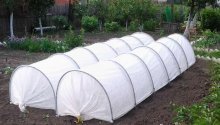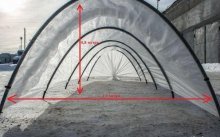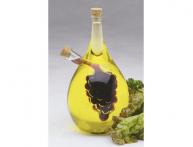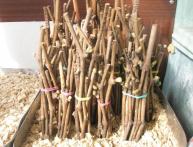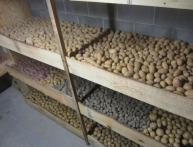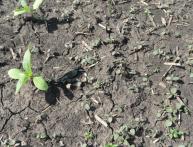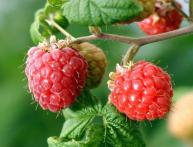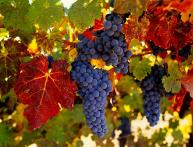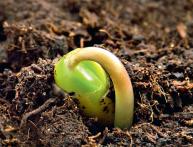Lutrasil, covering material for plant protection
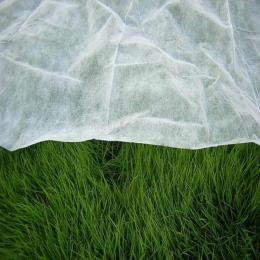
Many regions are geographically located in the zone of risky farming and in order to obtain a harvest, plants need protection from adverse weather conditions and weeds. In the memory of many gardeners there are still those times when gardening landings covered with improvised materials, such as boards, roofing felt, roofing felt, burlap. With the development of the chemical industry, the production of various plant protection materials was established.
They were distinguished by strength, durability and other parameters.
One of the modern samples is lutrasil, a covering material for gardens and vegetable gardens. It has certain properties and has several varieties. To understand what it is, it’s worth familiarizing yourself a little with modern technologies for the production of such materials and their main characteristics.
Content:
Nonwovens. Agrotextiles
Everyone knows that any fabric material is created from threads that are intertwined with each other in a certain way and form a fabric. Modern chemical production has mastered the technology of producing threads from polymer materials and connecting them to each other using:
- temperature regime, that is, by thermal methods
- using physical methods (needle punching)
- using chemical methods and combined techniques
Nonwovens get their name from various methods.connections that exclude the weaving method. Nonwoven materials are produced from the following natural raw materials:
- linen
- cotton
- wool
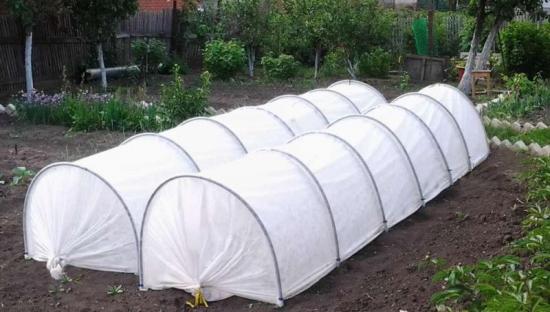
From chemical fibers:
- polyamide
- viscose
- polyester
- polypropylene
- polyacrylonitrile
Nonwoven materials made from chemical fibers have found wide application, including in the professional and amateur cultivation of fruits, berries, vegetables, and flowers. They received the general name agrotestil. The main purpose of agrotextiles is to protect and cover plants, as well as mulching soil under plants and between plantings. The most famous agrotextile is called spunbond. It is produced by hot blowing of polymers. The purpose of spunbond depends on:
- density
- weather resistance
- resistance to abrasion and creasing
- resistance to breaking loads
An important characteristic of spunbond when used in agriculture is its resistance to damage by sunlight. Special ultraviolet stabilizers are added to the polymer melt. It is worth saying that agrotextiles made from polypropylene using technology called spunbond are called differently in different countries:
- Ukraine - agrofibre, AGREEN
- Germany - lutrasil, LUTRASIL
- France - agril, novagril, AGRIL/ NOVAGRIL
Taking into account the fact that previously most often agrotextiles were imported from Germany, its more common name in amateur plant growing is lutrasil.
Lutrasil, its types
One of the main characteristics when choosing lutrasil is its density. It is usually indicated by numbers next to the name, for example:
- lutrasil thermoselect 17
- lutrasil thermoselect 23
- lutrasil frostselect 30
- lutrasil frostselect 60
The lightest and thinnest with a density of 17 grams per square meter. It looks no thicker than a spider's web. Capable of protecting against frost down to -2 degrees. Material with a density of 30 g/sq.m keeps frost down to -6 and serves as protection from heavy rain, wind and hail. Some of the densest versions of lutrasil with a density of 42 and 60 grams per square meter are suitable for creating greenhouses and greenhouses. Separately, it is worth mentioning Lutrasil 60 UV. It is dyed black by adding carbon black, is elastic and is impervious to sunlight. If you spread it on the garden bed, then weeds will not develop under it. Thus, depending on the density and other characteristics, lutrasil has four main purposes:
- protection from unfavorable temperatures protection from atmospheric agents
- mulching the soil
- weed control

When choosing lutrasil for a summer cottage or garden plot, the combination of price, quality and durability is important.
Lutrasil on site
Mulching
It is customary to use black Lutrasil to mulch paths, row spacing and plantings themselves.
In the spring, the bed prepared for planting crops is covered with black lutrasil and cuts are made into which the plants will be planted:
- strawberries
- onion
- tomatoes
- cucumbers
- other crops
Watering them is carried out in the same holes. Condensation does not collect on lutrasil, excessive dampness does not form underneath, mold does not appear and the earth remains loose. Currently, a two-color non-woven material has appeared for mulching beds. The top side is white, which prevents strong heating of the root system. When creating decorative paths, strips of lutrasil are laid under the main coating. This prevents weeds from appearing on the paths.The average service life of a mulch coating is three years.
Protective cover of plantings with lutrasil
Lutrasil with a density of 17 g/sq.m protects seedlings of heat-loving plants from frost from late frosts not exceeding - 3 degrees below zero. The denser version can be used to make tunnel shelters. Lutrasil with a density of 40 - 60 g/sq.m is used for the construction of greenhouses and greenhouses. It is important that there is unhindered penetration of air under the non-woven covering. If pollination is necessary, it is very easy to remove it for a while. The denser the lutrasil, the longer it lasts on the site. Plants grown under such cover develop better and yield earlier. To see this, it may be worth making small experimental beds and greenhouses out of lutrasil.
The video will show how to cover roses with lutrasil:
Interesting information about the vegetable garden

